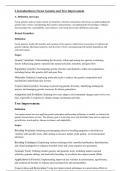Class notes
A Comprehensive Guide to Forest Genetics and Tree Improvement
- Course
- Institution
Forest genetics focuses on the genetic composition, variation, and heredity within tree populations. It involves understanding how genetic factors influence the characteristics and behaviors of trees, including their growth rate, resistance to diseases, adaptability to different environments, and w...
[Show more]



